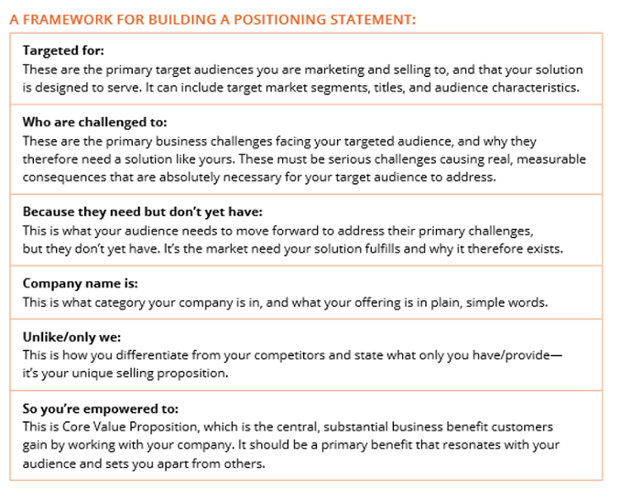Today’s B2B marketer needs a buyer-centric mentality and approach in order to successfully engage and convert prospects who are overwhelmed with businesses vying for their attention. But how can you be successful at buyer-centric marketing? It all begins with building the essential elements of a buyer-centric marketing strategy. In addition to buyer personas and buyer’s journey maps, these elements include brand identity and brand positioning and messaging.
A company’s brand is one of its most valuable assets. It’s ultimately the perception you create about your company in the marketplace and in the minds of your prospects by the many factors you use to communicate to your audience. To set your company apart, you need a powerful brand that connects with your buyers. The buyer insights you gain from your personas and journey maps are critical to influencing your brand, and you’ll need to consider these insights to craft a brand that resonates with your audience. Your brand must be consistently embodied in everything you communicate and in every touchpoint with your buyers.
Brand Identity
Brand identity is a collection of elements that define the essence of a brand. It includes internal brand elements like values, mission, and culture, and elements like promise, personality, and story that convey the external expression of the brand. A clearly defined brand identity influences every communication from social media posts to CEO earnings calls; it shapes the physical and psychological work space for your employees, and it creates affinity with the audience.
Your buyer persona insights will impact how you define your external brand identity elements, some of which include:
- Story: This is the chance to tell how and why the organization, business, and products came to be. The origins, evolutions, mission, successes, and trivia.
- Promise: All brands promise something to their customers and constituents. It is what they expect from a company. It is what the company signals it will do for the buyer.
- Personality: This is the collection of human traits and characteristics associated with the brand and organization. It’s important for developing trust, and the tone of voice in communications of all kinds and across all channels is a critical aspect of personality that must be consistently applied.
When preparing to build or refine your brand identity, it’s critical to secure executive sponsorship, including the CEO and other senior leaders. You must also identify participants, ideally a group of executives and managers across Sales, Marketing, Product, Services, and Support, and hold a series of working sessions where a facilitator ensures everyone in this group is free to share their thoughts.
Brand Positioning and Messaging
Positioning and messaging are the actual messages you hope to clearly communicate to the market or community in which a company operates. Positioning communicates the company’s role in the market relative to competitors or substitute offerings, the buyer’s need for its solution, and the value and critical capabilities of its solution or services, including how it’s differentiated. It gives everyone a common way to talk about the brand and is the foundation for all written and verbal communication.
Positioning and messaging tools include a positioning statement and a brand message map.
Positioning Statement
The positioning statement articulates the key elements of brand positioning. It’s often the elevator pitch and provides a clear, concise description of a company’s target market, as well as a compelling picture of how the company wants that market to perceive them.

When you are crafting your positioning statement, you must take into consideration key attributes of your buyer personas, including day-to-day business duties, how they’re evaluated/measured, their top business challenges, and their buying criteria.
Brand Message Map
The brand message map is a framework to capture your brand’s top-level messaging and core value proposition. Combined with the positioning statement, it serves as the foundational messaging that articulates the critical reasons why a business will want to consider and purchase offerings from a company.
 The brand message map includes, beginning from the base:
The brand message map includes, beginning from the base:
- A list of benefit statements: Each benefit statement is a feature/capability and its associated benefit that you do equal to or better than your competition. They should align to the very top needs of your buyer personas and each should be tagged to the relevant persona(s). Always view key persona attributes when drafting your benefit statements. Also, each benefit statement should have proof points, which are a repository of evidence to support your core value proposition, top-level messages, and benefits statements.
- The three top-level messages: Top-level messages are benefits the company provides its audience. Each top-level message is an umbrella embodying several related benefit statements. All three top-level messages should be buyer must-haves. At minimum, one must be both a must-have and an aspect of your offering that is superior to your competition (aka a key differentiator). The other two can be must-haves that are ideally differentiated, but may be simply on par or better than the competition.
- Core value proposition: The core value proposition is the central, substantial business benefit customers gain by working with your company. It answers why your target audience buys from you and not competitors. The core value proposition is often a combination of all 3 top-level messages and may be very similar or identical to a brand’s promise. It is also represented in the positioning statement. Your Core Value Proposition should be the benefit your buyers receive by leveraging your essential capabilities to address their primary challenge.
Building and refining a brand that deeply connects with your buyers is critical in today’s highly competitive, buyer-driven world. Your brand will impact everything from content creation, to campaign design, to website development, to social media marketing and more. The key is to collaboratively build your brand elements with your buyers and marketplace in mind, and to ensure the entire organization is aligned on them and can easily share and leverage them.

